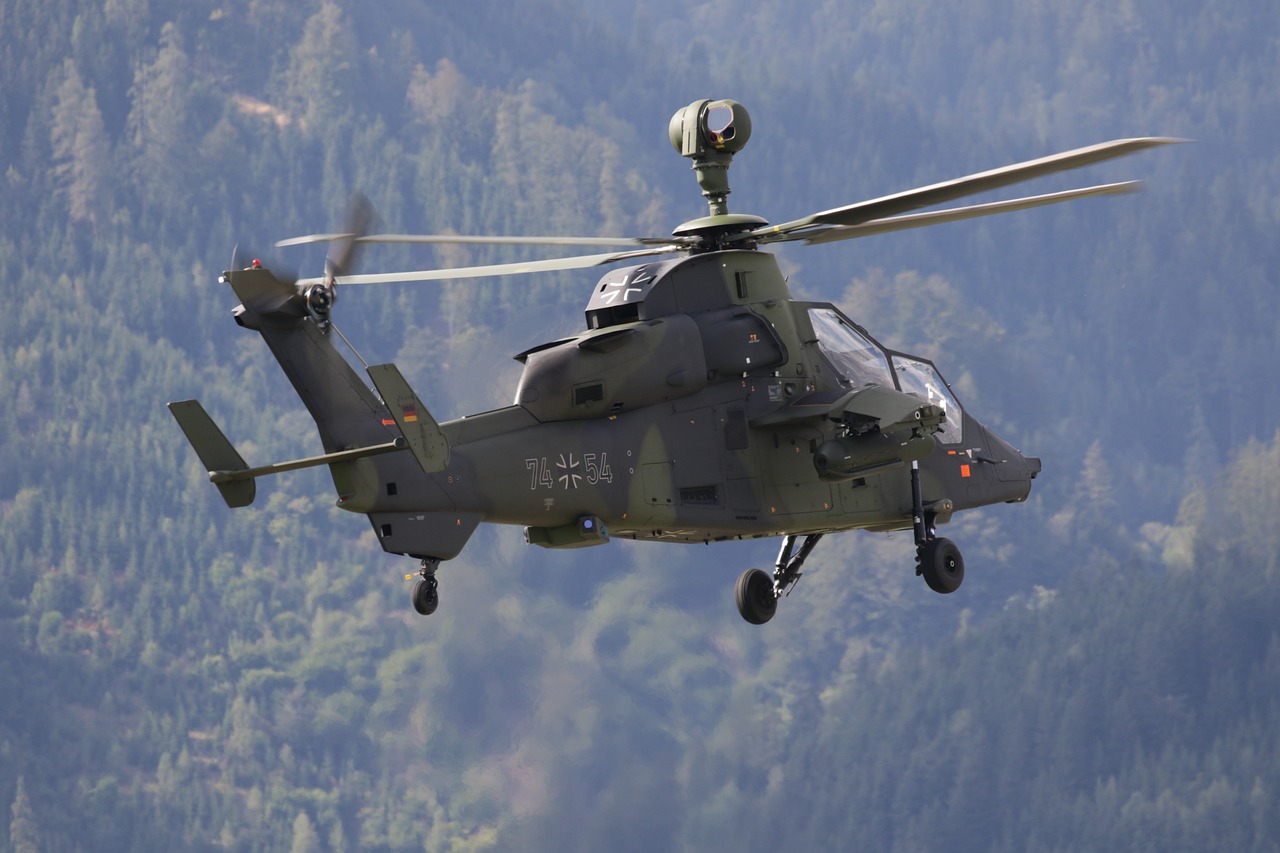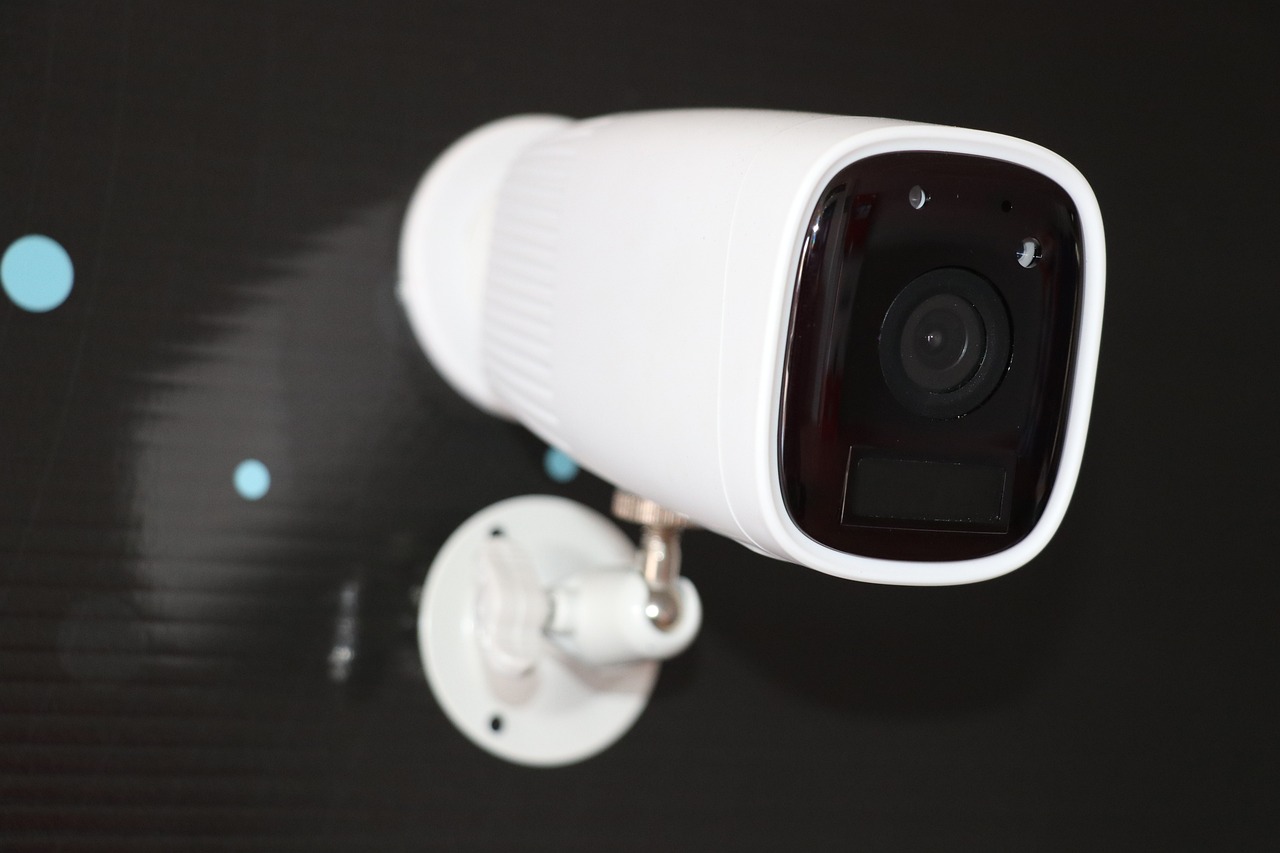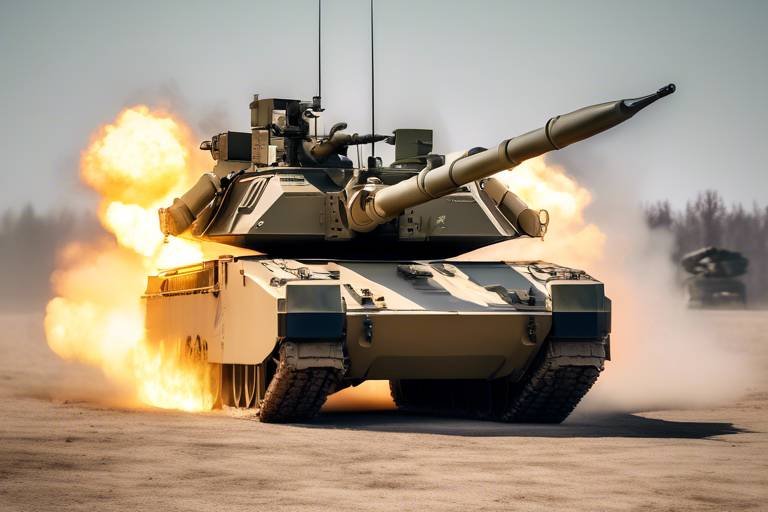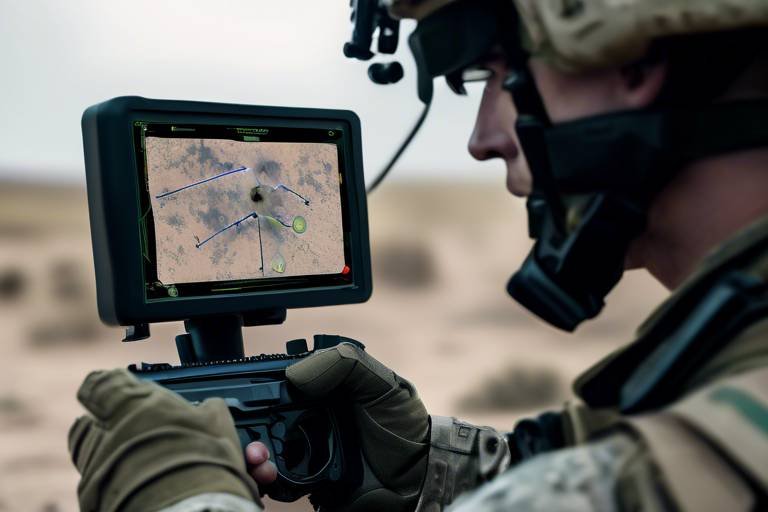How AI is Enhancing Military Surveillance and Counterintelligence
In recent years, the landscape of military operations has undergone a seismic shift, largely due to the integration of artificial intelligence (AI). This technology is not just a passing trend; it is fundamentally transforming how military forces conduct surveillance and counterintelligence activities. Imagine a world where vast amounts of data can be sifted through in seconds, pinpointing potential threats before they even materialize. This is the reality that AI is creating, and it’s making military operations more efficient, effective, and, most importantly, safer.
At its core, AI enhances military surveillance by significantly improving data collection, analysis, and decision-making. It empowers military personnel to gain deeper insights into their operational environments, allowing them to respond to threats with unprecedented speed and accuracy. Picture a battlefield where drones equipped with AI can autonomously identify enemy positions, or where satellites can analyze troop movements in real-time, adjusting strategies on the fly. This level of situational awareness is a game-changer, allowing for proactive measures rather than reactive ones.
Moreover, the role of AI extends beyond just surveillance. In the realm of counterintelligence, AI technologies are crucial in identifying and mitigating risks associated with espionage and cyber threats. With the ability to analyze communication patterns and detect anomalies, military forces can stay one step ahead of adversaries. AI not only helps in safeguarding sensitive information but also in ensuring that military operations are conducted with a high level of operational security.
However, the integration of AI into military frameworks is not without its challenges. As we embrace these technological advancements, we must also confront the ethical dilemmas they present. Questions arise regarding accountability, privacy, and the potential for misuse. How do we ensure that these powerful tools are used responsibly? What safeguards are in place to protect civilian rights while pursuing national security? These are critical discussions that must accompany the deployment of AI in military contexts.
Ultimately, the fusion of AI with military surveillance and counterintelligence is paving the way for a new era in national security. As we continue to explore the capabilities of AI, it’s essential to strike a balance between operational effectiveness and ethical considerations. The future of military operations may very well depend on how we navigate this intricate landscape.
- What is the primary benefit of AI in military surveillance? AI enhances the speed and accuracy of data analysis, allowing military forces to respond to threats more effectively.
- How does AI improve counterintelligence efforts? AI helps detect anomalies in communication and behavior patterns, which can indicate potential espionage or insider threats.
- What ethical concerns are associated with AI in military applications? Key concerns include accountability, privacy, and the potential for misuse of surveillance technologies.
- Can AI operate independently in military situations? While AI can assist in decision-making and data analysis, human oversight is crucial to ensure responsible deployment.

The Role of AI in Surveillance Technologies
This article explores the transformative role of artificial intelligence in military surveillance and counterintelligence, highlighting advancements, challenges, and future implications for national security.
Artificial intelligence is revolutionizing surveillance technologies, dramatically improving how military forces collect, analyze, and act upon data. Imagine a world where vast amounts of information are processed in real time, allowing military personnel to make split-second decisions based on accurate, up-to-date intelligence. This is no longer a futuristic dream; it is the reality we are stepping into. AI enhances situational awareness and operational effectiveness, fundamentally changing the landscape of military operations.
One of the most significant advantages of AI in surveillance is its ability to handle massive datasets. Traditional methods of data analysis often fall short when faced with the sheer volume of information generated in modern warfare. AI algorithms sift through this data, identifying crucial patterns and insights that would otherwise remain hidden. For instance, AI can analyze satellite imagery, drone footage, and social media interactions simultaneously, providing a comprehensive view of the battlefield.
Furthermore, AI technologies facilitate the development of real-time surveillance systems. These systems are not just about monitoring; they are about enhancing the decision-making process. With AI, military personnel can access critical information instantly, which is vital during high-stakes situations. Imagine a commander receiving immediate updates on enemy movements or potential threats, all thanks to an AI system that integrates data from various sources. This capability significantly boosts operational readiness and responsiveness.
Moreover, AI's ability to improve image recognition and classification is a game-changer. Deep learning techniques allow for more accurate identification of targets, enabling military forces to distinguish between friend and foe with unprecedented precision. No longer do military analysts have to rely solely on human judgment, which can be prone to error; AI brings a level of accuracy that enhances mission success rates.
However, it's essential to note that with great power comes great responsibility. The integration of AI in military surveillance raises ethical questions regarding privacy and accountability. As military operations become increasingly reliant on AI technologies, the potential for misuse or unintended consequences must be carefully considered. Establishing clear guidelines and oversight mechanisms is crucial to ensure that these powerful tools are used responsibly and ethically.
- What are the primary benefits of AI in military surveillance? AI enhances data processing capabilities, improves decision-making, and increases operational efficiency through real-time analysis.
- How does AI improve image recognition in surveillance? AI employs deep learning techniques to analyze images, allowing for more accurate identification of targets and threats.
- What ethical concerns arise from using AI in military operations? The use of AI raises issues related to privacy, accountability, and the potential for misuse, necessitating careful policy examination.

Data Analysis and Pattern Recognition
Artificial Intelligence (AI) is a game-changer in the realm of military data analysis and pattern recognition. Imagine trying to find a needle in a haystack, but instead of just one needle, there are thousands scattered throughout a massive field. This is akin to the challenge faced by military analysts who sift through an overwhelming amount of data daily. AI steps in to streamline this process, transforming chaos into clarity. By leveraging sophisticated algorithms, AI can analyze vast datasets far beyond the capability of human analysts, identifying patterns and trends that would typically go unnoticed.
One of the most significant advantages of AI in military operations is its ability to process data at lightning speed. For instance, machine learning algorithms can scan through hours of surveillance footage in mere minutes, pinpointing unusual activities or changes in behavior. This rapid analysis not only enhances situational awareness but also allows military personnel to make informed decisions swiftly. The ability to predict potential threats based on historical data is another powerful aspect of AI. By recognizing patterns in enemy movements or communication, military forces can anticipate actions and plan accordingly.
Machine learning algorithms are the backbone of AI's capabilities in data analysis. These algorithms learn from data inputs, improving their accuracy over time. They are particularly adept at handling complex datasets, enabling military analysts to uncover hidden insights that might otherwise remain buried. For example, a machine learning model can analyze social media data to detect shifts in public sentiment or emerging threats, providing valuable intelligence that can inform strategic decisions.
Deep learning, a subset of machine learning, takes this capability a step further. By utilizing neural networks, deep learning models can improve image recognition and classification tasks. In military contexts, this means that drones equipped with deep learning algorithms can identify specific targets amidst a crowded battlefield or monitor suspicious activities in real-time. The accuracy of these systems can significantly reduce the chances of collateral damage, ensuring that military operations are conducted with precision.
Another fascinating application of AI in military data analysis is Natural Language Processing (NLP). NLP enables machines to understand and interpret human language, allowing for the analysis of communication data. This capability is crucial for extracting intelligence from intercepted messages, emails, and even social media interactions. By analyzing the language used in these communications, military analysts can gain insights into enemy plans, motivations, and potential vulnerabilities.
The integration of AI-powered real-time surveillance systems further enhances military operations. These systems provide instant access to critical information, enabling military personnel to respond rapidly to emerging threats. Imagine being in a command center where every piece of data is analyzed in real-time, providing a comprehensive view of the battlefield. This level of situational awareness is invaluable, allowing for quicker decision-making and more effective responses to dynamic situations.
In conclusion, the role of AI in data analysis and pattern recognition is transforming military intelligence operations. By harnessing the power of machine learning, deep learning, and natural language processing, military forces can enhance their readiness against adversarial actions. As these technologies continue to evolve, the potential for AI to revolutionize military operations becomes even more apparent, paving the way for a future where data-driven decisions are the norm rather than the exception.
- What is the role of AI in military surveillance? AI enhances data collection, analysis, and decision-making processes, improving situational awareness and operational effectiveness.
- How does machine learning improve military intelligence? Machine learning algorithms analyze vast datasets quickly, uncovering hidden patterns and insights that inform strategic decisions.
- What are the ethical concerns regarding AI in military applications? Ethical considerations include accountability, privacy issues, and the potential for misuse, necessitating careful policy examination.
- Can AI predict potential threats in military operations? Yes, AI can analyze historical data to identify patterns and predict potential threats, enhancing military readiness.

Machine Learning Algorithms
Machine learning algorithms are at the forefront of transforming military intelligence operations. These algorithms are designed to process complex datasets, enabling military analysts to uncover hidden insights that would be nearly impossible to detect through traditional methods. Imagine trying to find a needle in a haystack; machine learning acts as a magnet, drawing out the critical information that can significantly enhance situational awareness and operational readiness. By leveraging vast amounts of data from various sources, including satellite imagery, drone footage, and intercepted communications, machine learning algorithms can identify patterns and trends that inform strategic decisions.
One of the most remarkable aspects of machine learning is its ability to learn from data over time. The more data these algorithms process, the better they become at recognizing anomalies and predicting potential threats. For example, in a military context, a machine learning model might analyze historical data on enemy movements to forecast their next steps, thereby giving military planners a tactical advantage. This predictive capability is akin to having a crystal ball that allows decision-makers to anticipate and mitigate risks before they escalate into serious threats.
To illustrate the impact of machine learning algorithms in military operations, consider the following table that outlines some of their key applications and benefits:
| Application | Benefit |
|---|---|
| Predictive Analytics | Enhances threat anticipation and strategic planning. |
| Data Classification | Improves the accuracy of intelligence reports by categorizing data effectively. |
| Real-time Monitoring | Enables immediate response to emerging threats based on live data analysis. |
| Automated Decision-Making | Streamlines operational processes and reduces human error in critical situations. |
As military operations become increasingly complex, the integration of machine learning algorithms offers a powerful tool for enhancing decision-making and operational efficiency. However, it is essential to recognize that while these technologies provide significant advantages, they also require careful implementation and oversight to ensure that they are used responsibly and effectively. This balance is crucial, as the stakes in military contexts are incredibly high, and the consequences of miscalculated decisions can be dire.
In summary, machine learning algorithms are revolutionizing the way military intelligence is gathered and analyzed. By harnessing the power of these advanced technologies, military organizations can not only improve their situational awareness but also enhance their overall operational effectiveness. As we move forward, the potential for machine learning to reshape military strategies and tactics will continue to grow, making it an indispensable component of modern warfare.
- What are machine learning algorithms?
Machine learning algorithms are computational methods that enable systems to learn from data and improve their performance over time without being explicitly programmed.
- How do machine learning algorithms benefit military operations?
They enhance data analysis, improve predictive capabilities, and provide real-time insights, which collectively aid in better decision-making and operational effectiveness.
- Are there any ethical concerns associated with using machine learning in the military?
Yes, ethical considerations include accountability, privacy concerns, and the potential for misuse of technology in military operations.

Deep Learning Applications
Deep learning, a subset of artificial intelligence, is making waves in military surveillance by significantly enhancing the capabilities of image recognition and classification systems. Imagine a scenario where military personnel can instantly identify and track potential threats in real-time, thanks to advanced algorithms that mimic the human brain's neural networks. This technology is akin to having a super-sleuth on the battlefield, tirelessly analyzing images and data to provide actionable intelligence.
One of the most remarkable aspects of deep learning is its ability to process vast amounts of visual data with incredible accuracy. For example, when drones capture high-resolution images of a target area, deep learning algorithms can analyze these images far more quickly than a human analyst could. This capability not only speeds up the decision-making process but also reduces the chances of human error, which can be critical in high-stakes situations. The applications of deep learning in military contexts include:
- Target Identification: Deep learning models can be trained to recognize specific vehicles, equipment, or personnel, allowing for precise targeting and minimizing collateral damage.
- Threat Monitoring: Continuous monitoring of areas of interest can be achieved through deep learning, enabling military forces to detect unusual patterns or movements that may indicate hostile activity.
- Facial Recognition: This technology can assist in identifying individuals of interest, enhancing situational awareness and operational security.
Furthermore, deep learning applications extend beyond visual data. They are also being integrated into audio and signal intelligence, allowing military analysts to decipher communications and detect anomalies that could signify a threat. By employing sophisticated algorithms, deep learning can sift through hours of audio recordings to find critical information that could otherwise go unnoticed.
As we look to the future, the implications of deep learning in military surveillance are profound. The ability to leverage this technology not only enhances operational effectiveness but also fundamentally changes how military forces approach intelligence gathering and threat assessment. However, with great power comes great responsibility, and the ethical considerations surrounding its use must be carefully navigated to ensure that these advancements are employed judiciously.
- What is deep learning? Deep learning is a subset of artificial intelligence that uses neural networks to analyze data and make predictions or decisions.
- How does deep learning improve military surveillance? It enhances image recognition and classification, allowing for quicker and more accurate identification of potential threats.
- Are there ethical concerns with using deep learning in the military? Yes, there are significant ethical considerations regarding privacy, accountability, and the potential for misuse of surveillance technologies.

Natural Language Processing
Natural Language Processing, or NLP, is a fascinating branch of artificial intelligence that focuses on the interaction between computers and humans through natural language. In the military context, NLP is becoming an essential tool for enhancing intelligence operations. Imagine being able to sift through mountains of communication data—emails, phone calls, social media posts—at lightning speed, extracting vital information that could mean the difference between success and failure in a mission.
One of the most significant advantages of NLP is its ability to process and analyze vast amounts of unstructured text data. This capability allows military analysts to identify trends, sentiments, and potential threats that might be hidden within the noise of everyday communications. For instance, by analyzing intercepted messages, NLP systems can detect unusual patterns of communication that may indicate espionage or insider threats. This is akin to finding a needle in a haystack, but with the help of AI, that needle becomes much easier to spot.
Moreover, NLP can facilitate real-time translation and transcription, enabling military personnel to understand foreign communications instantaneously. This is particularly crucial in joint operations with allied nations or when dealing with adversaries who speak different languages. By breaking down language barriers, NLP enhances collaboration and situational awareness, allowing for more coordinated and effective military responses.
However, the integration of NLP into military operations is not without its challenges. The technology must be trained to understand context, sarcasm, and idiomatic expressions, which can vary significantly from one culture to another. Additionally, the sheer volume of data can overwhelm even the most sophisticated NLP systems, necessitating continuous improvements and updates to algorithms.
In summary, Natural Language Processing is transforming how military organizations gather, analyze, and respond to intelligence. By leveraging this technology, military forces can enhance their operational effectiveness, making informed decisions that are crucial in today's rapidly evolving security landscape.
- What is Natural Language Processing? NLP is a field of artificial intelligence that enables computers to understand, interpret, and respond to human language.
- How does NLP benefit military operations? NLP helps in analyzing communication data to identify threats, translate foreign communications, and enhance situational awareness.
- What are the challenges of using NLP in the military? Challenges include understanding context, processing large volumes of data, and ensuring the accuracy of translations.
- Can NLP detect insider threats? Yes, NLP can analyze communication patterns to identify unusual activities that may indicate insider threats.

Real-time Surveillance Systems
In the fast-paced world of military operations, have become indispensable. Imagine being able to monitor a battlefield as if you were standing right there, with all the critical information at your fingertips. This is no longer a distant dream; it’s a reality thanks to the integration of artificial intelligence into surveillance technologies. These systems utilize advanced algorithms and data analytics to provide military personnel with instant access to vital information, enabling them to make quick decisions and respond to threats as they arise.
One of the most significant advantages of real-time surveillance systems is their ability to process and analyze data from multiple sources simultaneously. Whether it’s satellite imagery, drone footage, or ground-based sensors, AI can synthesize this information into a cohesive picture of the operational environment. This capability not only enhances situational awareness but also improves the chances of mission success. For instance, if a potential threat is detected, the system can automatically alert personnel and provide actionable insights, such as the location and nature of the threat.
Moreover, these systems are designed to operate in various conditions, from urban environments to remote terrains. They can adapt to changing scenarios, ensuring that military forces remain one step ahead of their adversaries. The integration of machine learning allows these systems to learn from past encounters, improving their predictive capabilities over time. This means that the more they are used, the better they get at identifying patterns and potential threats.
However, the implementation of real-time surveillance systems is not without its challenges. Issues such as data overload can occur, where the sheer volume of information generated becomes overwhelming. To combat this, military organizations are focusing on developing user-friendly interfaces that filter out noise and highlight critical data. Additionally, the need for robust cybersecurity measures is paramount, as these systems are prime targets for cyber attacks aimed at disrupting military operations.
In summary, real-time surveillance systems powered by AI represent a significant leap forward in military capabilities. They not only enhance operational efficiency but also provide a strategic advantage in an increasingly complex battlefield. As technology continues to evolve, we can expect these systems to become even more sophisticated, offering unparalleled support to military forces around the globe.
- What are real-time surveillance systems?
Real-time surveillance systems are advanced technologies that utilize AI to monitor and analyze data from various sources instantly, providing military personnel with critical information for decision-making.
- How does AI improve surveillance?
AI enhances surveillance by processing vast amounts of data quickly, identifying patterns, and predicting potential threats, which boosts situational awareness and operational effectiveness.
- What challenges do real-time surveillance systems face?
Challenges include data overload, cybersecurity threats, and the need for user-friendly interfaces to manage the information effectively.
- How can real-time surveillance systems impact military operations?
These systems can significantly improve operational efficiency, enhance situational awareness, and provide a strategic advantage in military engagements.

Counterintelligence Strategies Enhanced by AI
In the ever-evolving landscape of military operations, counterintelligence has taken on a new dimension with the integration of artificial intelligence (AI). The ability to swiftly identify and neutralize threats is paramount, and AI technologies are stepping up to the plate, transforming how military organizations approach these challenges. Imagine having a digital watchdog that never sleeps—always on the lookout for suspicious activities, deceptive practices, and potential breaches. This is the promise of AI in counterintelligence.
One of the most exciting aspects of AI in counterintelligence is its capability for threat detection and prevention. Advanced AI algorithms are designed to sift through colossal amounts of data, pinpointing anomalies that might go unnoticed by human analysts. For instance, when monitoring communication channels, AI can detect unusual patterns that suggest espionage or insider threats. This proactive stance allows military organizations to stay one step ahead, implementing measures to prevent breaches before they occur. Think of it as having a highly trained detective who can spot a lie before it’s even spoken.
Moreover, AI enhances the effectiveness of cybersecurity measures, which are crucial in today’s digital battlefield. Cyber threats are constantly evolving, and traditional security protocols often struggle to keep pace. AI-driven systems can identify vulnerabilities in real-time, enabling military units to respond swiftly to cyberattacks. This capability is not just about defense; it’s about creating a robust security posture that deters adversaries from even attempting an attack. In fact, AI can simulate various attack scenarios, allowing military personnel to prepare for potential threats before they materialize.
To illustrate the impact of AI in counterintelligence, consider the following table showcasing key advancements:
| AI Application | Description | Impact on Counterintelligence |
|---|---|---|
| Threat Detection Algorithms | AI systems analyze communication data to identify anomalies. | Proactive identification of insider threats. |
| Cybersecurity AI | Real-time monitoring of data systems for vulnerabilities. | Enhanced defense against cyberattacks. |
| Behavioral Analysis Tools | AI assesses personnel behavior for signs of deception. | Early detection of potential espionage activities. |
As military strategies evolve, the need for data-driven decision-making becomes increasingly apparent. AI not only helps in identifying threats but also aids in analyzing the effectiveness of counterintelligence strategies. By leveraging machine learning, military analysts can evaluate past incidents to refine their approaches, ensuring that they are always prepared for future challenges. This iterative process of learning and adapting is akin to a chess player anticipating moves ahead of time, making strategic decisions based on past games.
While the advantages of AI in counterintelligence are clear, it’s essential to approach its implementation with caution. Ethical considerations, such as privacy concerns and the potential for misuse, must be at the forefront of discussions. It’s crucial to strike a balance between enhancing national security and protecting individual rights. After all, the goal is not just to safeguard military operations but also to uphold the values that those operations defend.
- How does AI improve threat detection in military operations?
AI analyzes vast datasets to identify unusual patterns, enabling quicker responses to potential threats. - Can AI be misused in counterintelligence?
Yes, there are ethical concerns regarding privacy and accountability that need to be addressed. - What role does machine learning play in counterintelligence?
Machine learning helps in processing complex datasets, allowing for better insights and predictive analytics. - How does AI enhance cybersecurity measures?
AI identifies vulnerabilities and responds to cyber threats in real-time, protecting military data systems.

Threat Detection and Prevention
In today's rapidly evolving security landscape, have become paramount for military organizations. With the integration of artificial intelligence (AI), the ability to identify and mitigate potential threats is not just enhanced; it's revolutionized. AI algorithms are designed to sift through massive datasets at lightning speed, uncovering anomalies that could signify suspicious behavior or impending attacks. Imagine having a digital watchdog that never sleeps, constantly monitoring for signs of trouble—that's the power of AI in military surveillance.
One of the most significant advantages of AI in threat detection is its ability to operate in real-time. Traditional methods often rely on human analysts who can only process a limited amount of information at any given time. However, AI can analyze data from various sources, including satellite imagery, social media, and communication intercepts, all at once. This capability allows military personnel to stay one step ahead of adversaries, responding to threats before they escalate into crises.
For instance, AI-driven systems can detect unusual patterns in communication that may indicate a coordinated attack or espionage efforts. By employing advanced machine learning techniques, these systems learn from historical data, continuously improving their accuracy and effectiveness. This is akin to teaching a child to recognize different animals by showing them pictures—over time, they become adept at identifying even the most subtle differences.
Furthermore, AI systems can be programmed to prioritize threats based on their level of urgency. For example, a potential breach in a military network might be flagged as a higher priority than a minor irregularity in social media chatter. This prioritization ensures that military resources are allocated efficiently, focusing on the most pressing threats first. The result? A more agile and responsive military force.
However, the implementation of AI in threat detection is not without its challenges. The algorithms must be meticulously trained to avoid false positives—situations where innocent activities are mistakenly flagged as threats. This not only wastes valuable time and resources but can also lead to unnecessary panic or escalation. Therefore, continuous training and refinement of these algorithms are essential to maintain their effectiveness.
Moreover, as AI systems become more sophisticated, they also become more attractive targets for cyber adversaries. Ensuring the security of AI systems themselves is critical to maintaining operational integrity. Military organizations must invest in robust cybersecurity measures to protect these advanced technologies from being compromised, which could lead to catastrophic consequences.
In summary, AI's role in is a game-changer for military operations. By leveraging advanced algorithms and real-time data analysis, military forces can enhance their situational awareness and responsiveness. As we continue to navigate the complexities of modern warfare, embracing AI technology will be crucial to staying ahead of potential threats and ensuring national security.
- How does AI improve threat detection in the military?
AI analyzes vast amounts of data in real-time, identifying patterns and anomalies that could signify potential threats, thus enabling proactive measures. - What are the challenges of using AI for threat detection?
Challenges include the risk of false positives, the need for continuous training of algorithms, and the security of AI systems against cyber threats. - Can AI replace human analysts in military operations?
While AI can significantly enhance threat detection capabilities, human analysts are still essential for context, interpretation, and decision-making. - What role does machine learning play in military surveillance?
Machine learning algorithms help in processing complex datasets, allowing for better insights and predictions regarding potential threats.

Cybersecurity Measures
In today's rapidly evolving digital landscape, cybersecurity has become a cornerstone of military operations, especially with the integration of artificial intelligence (AI) technologies. AI plays a crucial role in fortifying military defenses against cyber threats, ensuring that sensitive information remains secure and operational integrity is maintained. One of the primary advantages of AI in this domain is its ability to identify vulnerabilities in real-time, allowing military organizations to proactively address potential breaches before they can be exploited.
For instance, AI systems can analyze network traffic patterns and detect anomalies that might indicate a cyber attack. By continuously monitoring these patterns, AI can quickly flag unusual activities that deviate from the norm, enabling cybersecurity teams to respond swiftly. This proactive approach not only enhances the security of military communications but also ensures the protection of classified data from adversaries.
Moreover, AI-driven cybersecurity measures can automate various tasks that traditionally required human intervention. This includes everything from threat detection to incident response. By leveraging machine learning algorithms, military cybersecurity systems can learn from past incidents, improving their ability to predict and mitigate future threats. This learning capability is akin to having a seasoned expert on the team who constantly evolves and adapts to new challenges.
Another significant aspect of AI in cybersecurity is its application in predictive analytics. By analyzing historical data and current trends, AI can forecast potential threats, allowing military personnel to be one step ahead of adversaries. This predictive capability is not just about reacting to threats; it's about anticipating them and implementing measures to prevent them from occurring in the first place.
To illustrate the effectiveness of AI in military cybersecurity, consider the following table that outlines key benefits:
| Benefit | Description |
|---|---|
| Real-time Threat Detection | AI systems monitor networks continuously to identify and respond to threats as they occur. |
| Automated Responses | AI can automate incident response, reducing the time it takes to address security breaches. |
| Predictive Analytics | AI analyzes data to predict potential threats, allowing preemptive measures to be taken. |
| Enhanced Decision-Making | AI provides actionable insights that assist military leaders in making informed decisions. |
However, the integration of AI in cybersecurity is not without challenges. As military organizations increasingly rely on these technologies, they must also contend with the potential for adversarial attacks on AI systems themselves. Cyber adversaries may attempt to manipulate AI algorithms, introducing biases or misleading data that could compromise military operations. Therefore, establishing robust safeguards and continuously updating AI systems is vital to maintaining a secure operational environment.
In conclusion, AI is revolutionizing cybersecurity measures within the military by enhancing threat detection, automating responses, and providing predictive insights. While challenges remain, the benefits of integrating AI into military cybersecurity frameworks are undeniable, offering a more resilient defense against the ever-evolving landscape of cyber threats.
- How does AI improve military cybersecurity?
AI enhances military cybersecurity by providing real-time threat detection, automating responses, and utilizing predictive analytics to foresee potential cyber threats. - What are the risks associated with AI in military applications?
Risks include the potential for adversarial attacks on AI systems, which could manipulate algorithms and compromise security measures. - Can AI completely replace human cybersecurity experts?
No, while AI can automate many processes and improve efficiency, human oversight is essential for ethical decision-making and strategic planning.

Ethical Considerations in AI Military Applications
The integration of artificial intelligence (AI) in military operations is not just a technological advancement; it brings forth a plethora of ethical dilemmas that demand our attention. As we stand on the brink of a new era in warfare, it is crucial to navigate the murky waters of accountability, privacy, and the potential for misuse. The implications of deploying AI in military contexts are profound, and they raise questions that go beyond mere technical feasibility.
One of the most pressing issues is accountability. When AI systems make decisions—be it in surveillance, targeting, or data analysis—who is responsible for those decisions? If an AI system erroneously identifies a target and results in civilian casualties, can we hold the developers, military commanders, or the AI itself accountable? This ambiguity necessitates the establishment of clear lines of responsibility and oversight to ensure that human judgment remains at the forefront of military decision-making.
Moreover, the use of AI in surveillance raises significant privacy concerns. With the capability to monitor vast swathes of data, AI can easily infringe on individual rights. The balance between national security and civilian privacy is a delicate one. Military operations often require intelligence gathering that can inadvertently invade the privacy of innocent individuals. How can we protect civilian rights while ensuring the effectiveness of military strategies? This question is pivotal and requires a thoughtful approach.
To better understand the ethical landscape, we can categorize the concerns into several key areas:
- Transparency: AI systems should operate in a manner that is understandable to human operators. This transparency is essential for ensuring trust and accountability.
- Bias and Fairness: AI algorithms can perpetuate existing biases if not carefully monitored. Military applications must ensure fairness in decision-making processes.
- Human Oversight: Maintaining human involvement in critical decisions is essential to prevent the potential for AI systems to operate without ethical considerations.
Another significant concern is the potential for misuse. The very capabilities that make AI a powerful tool in military applications—such as its ability to analyze data and make rapid decisions—could also be exploited for nefarious purposes. For instance, adversaries could develop their own AI systems to counter military strategies or even launch autonomous attacks. This arms race in AI technology poses a unique challenge, as nations must not only advance their own capabilities but also consider the ethical implications of their development.
As we delve deeper into the ethical considerations of AI in military applications, it becomes clear that there is no one-size-fits-all solution. Policymakers, military leaders, and technologists must collaborate to create frameworks that govern the use of AI in a way that is both effective and ethical. This collaboration should focus on establishing guidelines that prioritize human rights, ensure accountability, and promote transparency.
In conclusion, the ethical considerations surrounding AI in military applications are complex and multifaceted. As we embrace the potential of AI to enhance operational effectiveness, we must also remain vigilant about the moral implications of its use. The future of military operations will undoubtedly be shaped by AI, but it is our responsibility to ensure that this transformation aligns with our ethical standards and human rights.
- What are the main ethical concerns regarding AI in military applications? The primary concerns include accountability, privacy, transparency, bias, and the potential for misuse.
- How can we ensure accountability in AI military operations? Establishing clear lines of responsibility and oversight, along with maintaining human involvement in decision-making, is essential.
- What role does transparency play in AI military applications? Transparency helps build trust and ensures that AI systems operate in an understandable manner, allowing for better oversight and accountability.

Accountability and Oversight
As we dive deeper into the integration of artificial intelligence in military operations, one of the most pressing issues that arises is the question of accountability and oversight. With AI systems making critical decisions, often in real-time, the need for clear guidelines and responsible governance is paramount. Who is responsible when an AI-driven system makes a mistake? This uncertainty can create a legal and ethical minefield, making it essential to establish frameworks that ensure accountability.
To address these challenges, military organizations must implement robust oversight mechanisms. This includes forming dedicated committees that evaluate the use of AI technologies, ensuring they align with both operational goals and ethical standards. These committees should consist of a diverse range of stakeholders, including military personnel, ethicists, legal experts, and technologists. By bringing together various perspectives, the military can create a more comprehensive understanding of the implications of AI deployment.
Moreover, transparency plays a critical role in accountability. Military organizations should strive to make their AI systems as transparent as possible. This can involve documenting the decision-making processes of AI algorithms and making these records accessible for review. Transparency not only builds trust among military personnel but also fosters public confidence in military operations. After all, if the public can see how decisions are made and understand the rationale behind them, they are more likely to support military initiatives.
Another vital aspect is the establishment of clear ethical guidelines for AI use. These guidelines should outline acceptable practices and delineate the boundaries of AI applications in military contexts. For instance, the guidelines could specify that AI should not be used for autonomous lethal decision-making without human oversight. By setting these boundaries, military organizations can prevent potential abuses of AI technology and ensure that human judgment remains at the forefront of critical decisions.
In addition, continuous training and education for military personnel on AI technologies are essential. This training should not only cover the technical aspects of AI but also emphasize the ethical considerations involved. By equipping military personnel with a solid understanding of both the capabilities and limitations of AI, they can make more informed decisions and recognize when to question or override AI recommendations. This human-AI collaboration can significantly enhance operational effectiveness while maintaining ethical integrity.
In conclusion, the integration of AI in military operations presents both opportunities and challenges. By establishing strong accountability and oversight mechanisms, military organizations can harness the power of AI while safeguarding ethical standards and human rights. As we move forward, it is crucial to remember that technology should serve humanity, not the other way around. The balance between innovation and responsibility will ultimately shape the future of military operations.
- What is the role of AI in military accountability?
AI plays a significant role in enhancing accountability by providing data-driven insights into operational decisions, but it also raises questions about who is responsible for AI-driven actions. - How can military organizations ensure ethical AI use?
By establishing clear ethical guidelines, promoting transparency, and providing training for personnel on AI technologies, military organizations can ensure responsible AI use. - What are the risks of AI in military operations?
The risks include potential errors in decision-making, privacy concerns, and the possibility of misuse of AI technologies for unethical purposes. - Why is transparency important in military AI applications?
Transparency builds trust among stakeholders and the public, ensuring that AI systems operate within ethical boundaries and that decisions are made with accountability.

Privacy Concerns
As artificial intelligence increasingly permeates military operations, one of the most pressing issues that arises is the question of privacy. The integration of AI in surveillance technologies can lead to significant intrusions into personal privacy, raising alarms among civil liberties advocates. Imagine a world where every move you make, every conversation you have, and every digital footprint you leave is meticulously tracked and analyzed by algorithms designed to identify threats. This reality, while aimed at enhancing national security, can inadvertently lead to a surveillance state where individual freedoms are compromised.
The use of AI in military surveillance often involves collecting vast amounts of data from various sources, including social media, phone communications, and even public records. While this data can be invaluable for identifying potential threats, it also poses a risk of infringing on the rights of innocent civilians. The challenge lies in finding a balance between ensuring national security and protecting the privacy of individuals. A critical question arises: how do we ensure that AI is used ethically without overstepping boundaries?
Moreover, the lack of transparency in how AI systems operate can exacerbate privacy concerns. Many AI algorithms function as "black boxes," making it difficult to understand how decisions are made or what data is being collected. This opacity can lead to mistrust among the public and calls for stricter regulations governing the use of AI in military contexts. As we navigate this complex landscape, it’s essential to establish clear guidelines and accountability measures to protect civilian rights while still leveraging the benefits of AI.
To address these concerns, military organizations must engage in open dialogues with stakeholders, including privacy advocates, legal experts, and the general public. By fostering transparency and accountability, the military can work towards developing ethical frameworks that govern the use of AI technologies. This collaborative approach can help mitigate the risks associated with surveillance while ensuring that the primary goal of national security is achieved.
In summary, while AI has the potential to significantly enhance military operations, it is crucial to remain vigilant about the implications for privacy. The conversation around AI in military contexts should not only focus on technological advancements but also consider the ethical ramifications that come with them. As we advance into an era dominated by AI, we must ensure that our commitment to privacy and civil liberties remains steadfast.
- What are the main privacy concerns associated with AI in military surveillance? The primary concerns include the potential for mass data collection, lack of transparency in AI decision-making, and the risk of infringing on individual rights.
- How can military organizations ensure ethical use of AI? By establishing clear guidelines, promoting transparency, and engaging in dialogue with stakeholders, military organizations can mitigate privacy risks while leveraging AI technologies.
- What role do civilians play in shaping AI surveillance policies? Civilians can advocate for their rights and engage in discussions about privacy, helping to hold military organizations accountable for ethical AI use.
Frequently Asked Questions
- What role does AI play in military surveillance?
AI significantly enhances military surveillance by improving data collection, analysis, and decision-making processes. It enables military personnel to achieve better situational awareness and operational effectiveness, ensuring they are always a step ahead of potential threats.
- How does AI improve data analysis in military operations?
AI excels in analyzing vast amounts of data, identifying patterns, and predicting potential threats. This capability boosts military intelligence operations and enhances readiness, allowing analysts to uncover hidden insights and make informed decisions based on predictive analytics.
- What are machine learning algorithms, and why are they important?
Machine learning algorithms are essential for processing complex datasets. They help military analysts to detect trends and anomalies in data, which is crucial for maintaining operational security and responding swiftly to emerging threats.
- Can AI be used for real-time surveillance?
Absolutely! AI-powered real-time surveillance systems provide instant access to critical information, allowing military personnel to respond rapidly to threats. This capability enhances operational efficiency and situational awareness on the battlefield.
- How does AI contribute to counterintelligence?
AI technologies are vital in counterintelligence, helping detect deceptive practices and monitor insider threats. They also safeguard sensitive information from espionage and cyber attacks, ensuring the integrity of military operations.
- What ethical concerns arise from using AI in military applications?
The integration of AI in military operations raises ethical questions regarding accountability, privacy, and potential misuse. It's crucial to examine policies governing AI use to ensure responsible deployment while balancing operational effectiveness with ethical obligations.
- How can military organizations ensure accountability in AI deployment?
Establishing clear lines of accountability and oversight is essential. Military organizations must implement policies that balance operational effectiveness with ethical considerations and human rights to ensure responsible AI deployment.
- What privacy concerns are associated with AI surveillance?
The use of AI in surveillance can lead to significant privacy issues, prompting discussions on protecting civilian rights while maintaining national security. It's vital to establish guidelines that respect individual privacy while ensuring effective military operations.



















